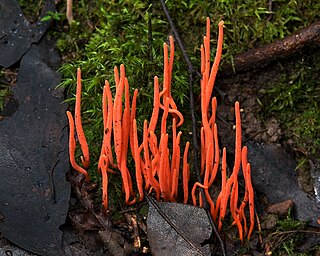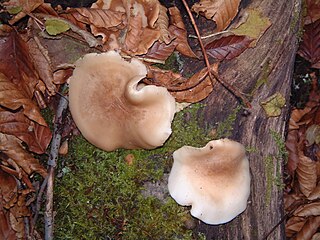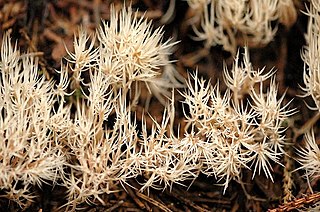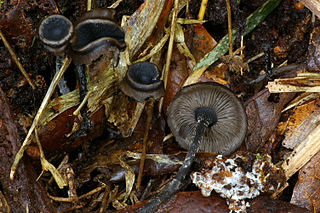| Arthromyces | |
|---|---|
| Scientific classification | |
| Kingdom: | |
| Division: | |
| Class: | |
| Order: | |
| Family: | |
| Genus: | Arthromyces T.J. Baroni & Lodge |
| Type species | |
| Arthromyces claviformis T.J. Baroni & Lodge | |
| Species | |
Arthromyces is a genus of fungi in the Lyophyllaceae family. [1] The genus contain two species found in Central America. [2]

The Agaricales are an order of fungi in the division Basidiomycota. As originally conceived, the order contained all the agarics, but subsequent research has shown that not all agarics are closely related and some belong in other orders, such as the Russulales and Boletales. Conversely, DNA research has also shown that many non-agarics, including some of the clavarioid fungi and gasteroid fungi belong within the Agaricales. The order has 46 extant families, more than 400 genera, and over 25,000 described species, along with six extinct genera known only from the fossil record. Species in the Agaricales range from the familiar Agaricus bisporus and the deadly Amanita virosa to the coral-like Clavaria zollingeri and bracket-like Fistulina hepatica.

The Pluteaceae are a family of small to medium-sized mushrooms which have free gill attachment and pink spores. Members of Pluteaceae can be mistaken for members of Entolomataceae, but can be distinguished by the angled spores and attached gills of the Entolomataceae. The four genera in the Pluteaceae comprise the widely distributed Volvariella and Pluteus, the rare Chamaeota, and Volvopluteus, which was newly described in 2011 as a result of molecular analysis. The Dictionary of the Fungi estimates there are 364 species in the family.

The Clavariaceae are a family of fungi in the order Agaricales. Originally the family contained most of the clavarioid fungi, but in its current sense is more restricted, albeit with a greater diversity of basidiocarp forms. Basidiocarps are variously clavarioid or agaricoid (mushroom-shaped), less commonly corticioid or hydnoid.

The Agaricomycetes are a class of fungi in the division Basidiomycota. The taxon is roughly identical to that defined for the Homobasidiomycetes by Hibbett & Thorn, with the inclusion of Auriculariales and Sebacinales. It includes not only mushroom-forming fungi, but also most species placed in the deprecated taxa Gasteromycetes and Homobasidiomycetes. Within the subdivision Agaricomycotina, which already excludes the smut and rust fungi, the Agaricomycetes can be further defined by the exclusion of the classes Tremellomycetes and Dacrymycetes, which are generally considered to be jelly fungi. However, a few former "jelly fungi", such as Auricularia, are classified in the Agaricomycetes. According to a 2008 estimate, Agaricomycetes include 17 orders, 100 families, 1147 genera, and about 21000 species. Modern molecular phylogenetic analyses have been since used to help define several new orders in the Agaricomycetes: Amylocorticiales, Jaapiales, Stereopsidales, and Lepidostromatales.

Hypsizygus tessulatus, the beech mushroom, is an edible mushroom native to East Asia. It is cultivated locally in temperate climates in Europe, North America and Australia and sold fresh in super markets. In nature, these are gilled mushrooms that grow on wood. Most often the mushroom is found on beech trees, hence the common name. Cultivated versions are often small and thin in appearance and popular in many nations across the world.

The Hymenogastraceae is a family of fungi in the order Agaricales with both agaric and false-truffle shaped fruitbodies. Formerly, prior to molecular analyses, the family was restricted to the false-truffle genera. The mushroom genus Psilocybe in the Hymenogastraceae is now restricted to the hallucinogenic species while nonhallucinogenic former species are largely in the genus Deconica classified in the Strophariaceae.

The Physalacriaceae are a family of fungi in the order Agaricales. Species in the family have a widespread distribution, ranging from the Arctic, (Rhizomarasmius), to the tropics, e.g. Gloiocephala, and from marine sites (Mycaureola) and fresh waters (Gloiocephala) to semiarid forests (Xerula).

The Pterulaceae are a family of fungi in the order Agaricales. According to a 2008 estimate, the family contained 99 species previously distributed among 12 genera. More recent data from molecular phylogenetic reconstruction showed that members of the genus Parapterulicium are unrelated to Pterulaceae and also polyphyletic. A new genus Baltazaria was created and both genera were moved to Russulales, to families Lachnocladiaceae and Peniophoraceae respectively.
Arthrosporella is a fungal genus in the family Tricholomataceae. It is a monotypic genus, containing the single species Arthrosporella ditopa, found in South America. The genus was described by mycologist Rolf Singer in 1970.

Ossicaulis is a ditypic genus of mushrooms in the family Lyophyllaceae.

Hypsizygus is a small genus of fungi that are widely distributed in north temperate regions. The genus was circumscribed by Rolf Singer in 1947. The common name for Hypsizygus ulmarius is the elm oyster mushroom.

Blastosporella is a fungal genus in the family Lyophyllaceae. The genus is monotypic, containing the single South American species Blastosporella zonata, described as new to science in 2007. The fungus produces fruit bodies characterized by producing spherical balls of blastospores that cover the cap surface in maturity.
Morganella is a genus of puffball fungi in the family Agaricaceae. The genus name honors American botanist Andrew Price Morgan (1836–1907). The widely distributed genus is prevalent in tropical areas. A 2008 estimate placed nine species in Morganella, but several new species have since been described.
Sphagnurus is a parasitic mushroom genus in the family Lyophyllaceae that creates conspicuous dead patches on peat moss (Sphagnum) in bogs. The genus contains one species known to inhabit Eurasia and North America. Phylogenetically the genus is closest to, but is isolated from species now classified in the genus Sagaranella Prior to molecular analyses, the most recent classification put it in the genus Tephrocybe, but that genus is allied to Termitomyces.
Sagaranella is a mushroom genus in the family Lyophyllaceae that has been segregated from both Lyophyllum and Tephrocybe using molecular analyses. The species resemble grey colored Collybias and grow in nitrogen-rich environments.
Myochromella is a mushroom genus in the family Lyophyllaceae that has been segregated from both Lyophyllum and Tephrocybe using molecular analyses and was first informally labelled clade 'mycochromella' or section 'Tephrophana p.p.' before being recognized as a genus. The species resemble grey colored Collybias and grow in forests.
Lyophyllum konradium is a species of mushroom-forming fungus in the family Lyophyllaceae.